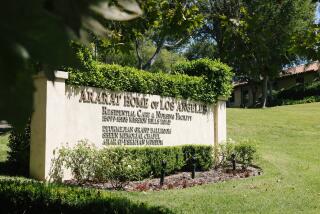Misinterpretation of Hospital Death Rate Data Feared
- Share via
Medical and hospital authorities warned Wednesday that death rates for Medicare patients at hospitals throughout the country, released by the government in Washington, may have no bearing on the quality of care at those hospitals.
The information was compiled by the Health Care Finance Administration from hospital billing data, and not from the findings of federally mandated review committees in each state whose job is to check the quality of care, according to Leon Starr, financial vice president of the Hospital Council of Southern California.
“The quality of care will be determined when there has been a review of the medical records rather than the billing information,” Starr said. Much of the information that was released can be misinterpreted, physicians and hospital administrators pointed out.
For example, the reason for the high death rate at Barlow Hospital in Los Angeles, which led California’s total mortality rate list, is that it admits mostly terminally ill patients suffering from emphysema, lung cancer, chronic bronchitis and other respiratory diseases.
According to Dr. Hans E. Einstein, Barlow’s medical director, three-fourths of its admissions are patients on mechanical ventilators and have been referred there by other hospitals. Barlow specializes in treating such patients.
Similarly, the total mortality rate for other hospitals, such as the City of Hope Medical Center in Duarte, may also be prone to misinterpretation. Most of the hospital’s patients are seriously ill patients, a spokesman said.
On the other hand, some hospitals may look unusually good when their mortality data for a specific diagnosis, such as heart attack, is considered.
For example, the record for Century City Hospital showed that there were no deaths among the 41 Medicare patients treated for heart attack in 1984, although the federal agency had predicted that 23.3% could be expected.
The hospital, it turns out, accepts only elective heart patients, according to Joel Bergenfeld, its executive director. It also does not do open-heart surgeries.
“So the very sick (heart attack patients) go to Cedars-Sinai Medical Center or UCLA Hospital . . .” Bergenfeld said.
The federal report showed that Cedars-Sinai had a lower-than-expected heart attack mortality rate. UCLA was not listed.
Dr. Samuel Sapin, associate medical director for Kaiser’s Permanente Medical Group, said it is not possible to draw any conclusions about quality unless all of the patients under study have the same risk of dying. That was not the case in the government reports.
In order to equate mortality rates with quality, he said, factors that also must be considered include whether a heart attack patient also had diabetes, whether it was his first or third heart attack, the patients’ ages and many other conditions.
Commenting on the higher-than-expected mortality from pneumonia at several Kaiser hospitals, as well as at all other hospitals listed for that diagnosis, Sapin said that factors such as age, socioeconomic level and the type of germ causing the disease would be crucial in evaluating the outcome.
Dogan Daldal, administrator of the 99-bed Oroville Hospital in Northern California, which was listed as having excessive deaths from pneumonia, heart attack and gallbladder surgery, said the distance to the nearest major medical center played a role. “We do keep difficult cases because this is a community hospital and our patients don’t want to go out of town,” he said.
More to Read
Sign up for Essential California
The most important California stories and recommendations in your inbox every morning.
You may occasionally receive promotional content from the Los Angeles Times.











